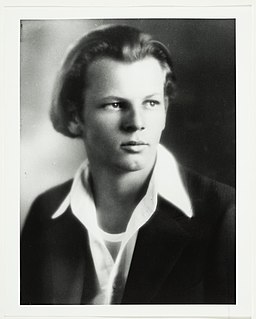
Paul Jackson Pollock was an American painter and a major figure in the abstract expressionist movement. He was widely noticed for his "drip technique" of pouring or splashing liquid household paint onto a horizontal surface, enabling him to view and paint his canvases from all angles. It was also called all-over painting and action painting, since he covered the entire canvas and used the force of his whole body to paint, often in a frenetic dancing style. This extreme form of abstraction divided the critics: some praised the immediacy of the creation, while others derided the random effects. In 2016, Pollock's painting titled Number 17A was reported to have fetched US$200 million in a private purchase.

A mural is any piece of graphic artwork that is painted or applied directly to a wall, ceiling or other permanent substrate. Mural techniques include fresco, mosaic, graffiti and marouflage.

Social realism is the term used for work produced by painters, printmakers, photographers, writers and filmmakers that aims to draw attention to the real socio-political conditions of the working class as a means to critique the power structures behind these conditions. While the movement's characteristics vary from nation to nation, it almost always utilizes a form of descriptive or critical realism.
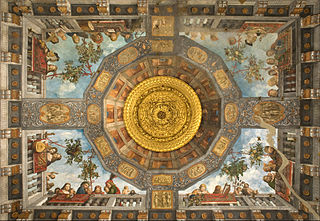
Trompe-l'œil is an art technique that uses realistic imagery to create the optical illusion that the depicted objects exist in three dimensions. Forced perspective is a comparable illusion in architecture.
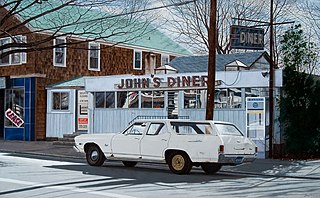
Photorealism is a genre of art that encompasses painting, drawing and other graphic media, in which an artist studies a photograph and then attempts to reproduce the image as realistically as possible in another medium. Although the term can be used broadly to describe artworks in many different media, it is also used to refer specifically to a group of paintings and painters of the American art movement that began in the late 1960s and early 1970s.

Evert Collier was a Dutch Golden Age still-life painter known for vanitas and trompe-l'œil paintings. His first name is sometimes spelled "Edward" or "Edwaert" or "Eduwaert" or "Edwart," and his last name is sometimes spelled "Colyer" or "Kollier".
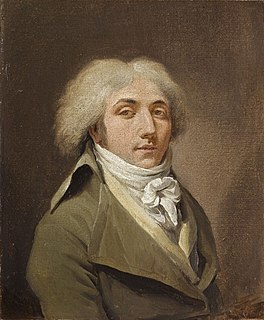
Louis-Léopold Boilly was a French painter and draftsman. A gifted creator of popular portrait paintings, he also produced a vast number of genre paintings vividly documenting French middle-class social life. His life and work spanned the eras of monarchical France, the French Revolution, the Napoleonic Empire, the Bourbon Restoration and the July Monarchy. His 1800 painting Un Trompe-l'œil introduced the term trompe-l'œil, applied to the technique that uses realistic imagery to create the optical illusion that the depicted objects exist in three dimensions, though the "unnamed" technique itself had existed in Greek and Roman times.
Richard John Haas is an American muralist who is best known for architectural murals and his use of the trompe-l'œil style.
Alton Stanley Tobey, the American artist, was a painter, historical artist, muralist, portraitist, illustrator, and teacher of art.

Anton Refregier was a painter and muralist active in Works Progress Administration Federal Art Project commissions, and in teaching art. He was a Russian immigrant to the United States.

Cornelis Norbertus Gijsbrechts or Gysbrechts was a Flemish painter who was active in the Spanish Netherlands, Germany, Denmark and Sweden in the second half of the seventeenth century. He was a court painter to the Danish royal family. He specialised in trompe-l'œil still lifes, an artistic genre which uses visual tricks to give viewers the illusion that they are not looking at a painting but rather at real three-dimensional objects. He also created many vanitas still lifes.
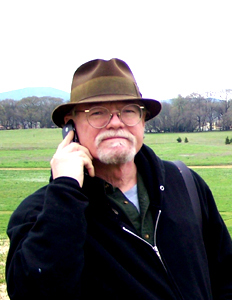
Robert Dafford is an American muralist.

Illusionism in art history means either the artistic tradition in which artists create a work of art that appears to share the physical space with the viewer or more broadly the attempt to represent physical appearances precisely – also called mimesis. The term realist may be used in this sense, but that also has rather different meanings in art, as it is also used to cover the choice of ordinary everyday subject-matter, and avoiding idealizing subjects. Illusionism encompasses a long history, from the deceptions of Zeuxis and Parrhasius to the works of muralist Richard Haas in the twentieth century, that includes trompe-l'œil, anamorphosis, optical art, abstract illusionism, and illusionistic ceiling painting techniques such as di sotto in sù and quadratura. Sculptural illusionism includes works, often painted, that appear real from a distance. Other forms, such as the illusionistic tradition in the theatre, and Samuel van Hoogstraten's "peepshow"-boxes from the seventeenth century, combine illusionistic techniques and media.

Mexican Muralism refers to an art project funded by the Mexican government in an attempt to reunify the country under the government post-Mexican Revolution. The project was to allow artists to promote political ideas regarding the social revolution that had just recently ended so that viewers may reflect on how pivotal the revolution was in Mexican history. This was accomplished by way of painting murals, large artworks painted onto the wall itself, containing general social and political messages. Beginning in the 1920s, the muralist project was headed by a group of artists known as "The Big Three" or "The Three Greats". This group was composed of Diego Rivera, José Clemente Orozco and David Alfaro Siqueiros. From the 1920s to the 1970s, many murals with nationalistic, social and political messages were displayed in many public settings such as chapels, schools, government buildings, and much more. The popularity of the Mexican muralist project started a tradition which continues to this day in Mexico; a tradition that has had a significant impact in other parts of the Americas, including the United States, where it served as inspiration for the Chicano art movement.
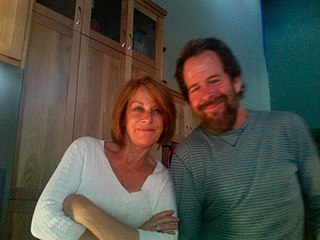
John Pugh is an American artist known for creating large trompe-l'œil wall murals giving the illusion of a three-dimensional scene behind the wall. Pugh has been creating his murals since the late 1970s. He attended California State University Chico, receiving his BA in 1983 and the Distinguished Alumni Award in 2003. He has received over 250 public and private commissions in the United States, Canada, Mexico, Barbados, Japan, Taiwan, and New Zealand. He currently lives and works in Truckee, California. His particular style of trompe-l'œil painting has been called "Narrative Illusionism."
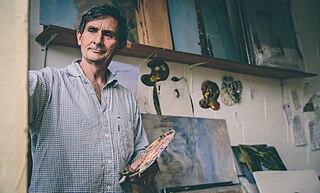
Michael Alford is a British figurative painter whose work includes landscapes, cityscapes, figures, portraits, nudes and murals.

Various types of visual arts developed in the geographical area now known as Mexico. The development of these arts roughly follows the history of Mexico, divided into the prehispanic Mesoamerican era, the colonial period, with the period after Mexican War of Independence, the development Mexican national identity through art in the nineteenth century, and the florescence of modern Mexican art after the Mexican Revolution (1910-1920).

Franciscus Gijsbrechts, was a Flemish painter of still lifes specialised in vanitas still lifes and trompe-l'œil paintings. He worked in the second half of the seventeenth century in the Spanish Netherlands, Denmark and the Dutch Republic. Like his father, he painted trompe-l'œil still lifes, a still life genre that uses illusionistic means to create the appearance that the painted, two-dimensional composition is actually a three-dimensional, real object.
George Martin Battersby was a British trompe-l'œil artist and theatrical set decorator who became an expert on Art Nouveau and the style of the 1920s and 1930s.
Mehdi Ghadyanloo is an Iranian artist, painter, and muralist. Known for his gigantic trompe-l'œil-style murals in central Tehran, Ghadyanloo has become the most prolific Iranian public artist with over 100 murals across the globe in the USA, the UK, Russia and his native Iran. Ghadyanloo also creates paintings, with surreal and minimalistic themes. While his colourful commissioned mural works have led to him being simplistically coined as Iran’s answer to Banksy by the press, Ghadyanloo is more inclined to draw comparisons with European surrealist painters such as Magritte, Girgio de Chirico and the minimal lines of modernist 20th century architects such as Le Corbusier. Mehdi takes his inspirations of Giorgio de Chirico, Magritte, and the minimalism of Le Corbusier, and turns them into a voice all of his own.















